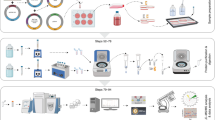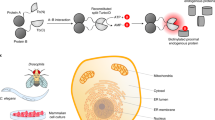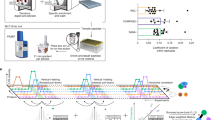Abstract
Tandem affinity purification (TAP) is a generic two-step affinity purification protocol that enables the isolation of protein complexes under close-to-physiological conditions for subsequent analysis by mass spectrometry. Although TAP was instrumental in elucidating the yeast cellular machinery, in mammalian cells the method suffers from a low overall yield. We designed several dual-affinity tags optimized for use in mammalian cells and compared the efficiency of each tag to the conventional TAP tag. A tag based on protein G and the streptavidin-binding peptide (GS-TAP) resulted in a tenfold increase in protein-complex yield and improved the specificity of the procedure. This allows purification of protein complexes that were hitherto not amenable to TAP and use of less starting material, leading to higher success rates and enabling systematic interaction proteomics projects. Using the well-characterized Ku70-Ku80 protein complex as an example, we identified both core elements as well as new candidate effectors.
*Note: In the version of this article initially published online, the GS-TAP tag in Figure 3b was incorrectly identified as a GC-TAP tag, and the email address for material requests (materials@cemm.oeaw.ac.at) was omitted from the methods section. The errors have been corrected for all versions of the article.
This is a preview of subscription content, access via your institution
Access options
Subscribe to this journal
Receive 12 print issues and online access
$259.00 per year
only $21.58 per issue
Buy this article
- Purchase on SpringerLink
- Instant access to full article PDF
Prices may be subject to local taxes which are calculated during checkout






Similar content being viewed by others
Change history
06 October 2006
In the version of this article initially published online, the GS-TAP tag in Figure 3b was incorrectly identified as a GC-TAP tag, and the email address for material requests (materials@cemm.oeaw.ac.at) was omitted from the methods section. The errors have been corrected for all versions of the article.
References
Alberts, B. The cell as a collection of protein machines: preparing the next generation of molecular biologists. Cell 92, 291–294 (1998).
Papin, J.A., Hunter, T., Palsson, B.O. & Subramaniam, S. Reconstruction of cellular signalling networks and analysis of their properties. Nat. Rev. Mol. Cell Biol. 6, 99–111 (2005).
Bauch, A. & Superti-Furga, G. Charting protein complexes, signaling pathways, and networks in the immune system. Immunol. Rev. 210, 187–207 (2006).
Hinsby, A.M. et al. A wiring of the human nucleolus. Mol. Cell 22, 285–295 (2006).
Fox, A.H. & Lamond, A.I. Nuclear processes controlled by molecular machines. Genome Biol. 3 REPORTS4016 (2002).
Aebersold, R. & Mann, M. Mass spectrometry-based proteomics. Nature 422, 198–207 (2003).
Puig, O. et al. The tandem affinity purification (TAP) method: a general procedure of protein complex purification. Methods 24, 218–229 (2001).
Rigaut, G. et al. A generic protein purification method for protein complex characterization and proteome exploration. Nat. Biotechnol. 17, 1030–1032 (1999).
Gavin, A.C. et al. Functional organization of the yeast proteome by systematic analysis of protein complexes. Nature 415, 141–147 (2002).
Gavin, A.C. et al. Proteome survey reveals modularity of the yeast cell machinery. Nature 440, 631–636 (2006).
Ho, Y. et al. Systematic identification of protein complexes in Saccharomyces cerevisiae by mass spectrometry. Nature 415, 180–183 (2002).
Bouwmeester, T. et al. A physical and functional map of the human TNF-alpha/NF-kappa B signal transduction pathway. Nat. Cell Biol. 6, 97–105 (2004).
Butland, G. et al. Interaction network containing conserved and essential protein complexes in Escherichia coli. Nature 433, 531–537 (2005).
Brajenovic, M., Joberty, G., Kuster, B., Bouwmeester, T. & Drewes, G. Comprehensive proteomic analysis of human Par protein complexes reveals an interconnected protein network. J. Biol. Chem. 279, 12804–12811 (2004).
Terpe, K. Overview of tag protein fusions: from molecular and biochemical fundamentals to commercial systems. Appl. Microbiol. Biotechnol. 60, 523–533 (2003).
Ghosh, S. & Karin, M. Missing pieces in the NF-kappaB puzzle. Cell 109, S81–S96 (2002).
Sjobring, U., Bjorck, L. & Kastern, W. Streptococcal protein G. Gene structure and protein binding properties. J. Biol. Chem. 266, 399–405 (1991).
Sauer-Eriksson, A.E., Kleywegt, G.J., Uhlen, M. & Jones, T.A. Crystal structure of the C2 fragment of streptococcal protein G in complex with the Fc domain of human IgG. Structure 3, 265–278 (1995).
Keefe, A.D., Wilson, D.S., Seelig, B. & Szostak, J.W. One-step purification of recombinant proteins using a nanomolar-affinity streptavidin-binding peptide, the SBP-Tag. Protein Expr. Purif. 23, 440–446 (2001).
Collis, S.J., DeWeese, T.L., Jeggo, P.A. & Parker, A.R. The life and death of DNA-PK. Oncogene 24, 949–961 (2005).
Gottlieb, T.M. & Jackson, S.P. The DNA-dependent protein kinase: requirement for DNA ends and association with Ku antigen. Cell 72, 131–142 (1993).
Li, B. & Comai, L. Functional interaction between Ku and the werner syndrome protein in DNA end processing. J. Biol. Chem. 275, 28349–28352 (2000).
Aoki, Y., Zhao, G., Qiu, D., Shi, L. & Kao, P.N. CsA-sensitive purine-box transcriptional regulator in bronchial epithelial cells contains NF45, NF90, and Ku. Am. J. Physiol. 275, L1164–L1172 (1998).
Crevel, G., Ivetic, A., Ohno, K., Yamaguchi, M. & Cotterill, S. Nearest neighbour analysis of MCM protein complexes in Drosophila melanogaster. Nucleic Acids Res. 29, 4834–4842 (2001).
Fouraux, M.A., Bouvet, P., Verkaart, S., van Venrooij, W.J. & Pruijn, G.J. Nucleolin associates with a subset of the human Ro ribonucleoprotein complexes. J. Mol. Biol. 320, 475–488 (2002).
Park, J., Wood, M.A. & Cole, M.D. BAF53 forms distinct nuclear complexes and functions as a critical c-Myc-interacting nuclear cofactor for oncogenic transformation. Mol. Cell. Biol. 22, 1307–1316 (2002).
Krogan, N.J. et al. Global landscape of protein complexes in the yeast Saccharomyces cerevisiae. Nature 440, 637–643 (2006).
Brown, D. & Superti-Furga, G. Rediscovering the sweet spot in drug discovery. Drug Discov. Today 8, 1067–1077 (2003).
Fishman, M.C. & Porter, J.A. Pharmaceuticals: a new grammar for drug discovery. Nature 437, 491–493 (2005).
Cheeseman, I.M. & Desai, A. A combined approach for the localization and tandem affinity purification of protein complexes from metazoans. Sci. STKE 2005, pl1 (2005).
Bertwistle, D., Sugimoto, M. & Sherr, C.J. Physical and functional interactions of the Arf tumor suppressor protein with nucleophosmin/B23. Mol. Cell. Biol. 24, 985–996 (2004).
Canton, D.A. et al. The pleckstrin homology domain-containing protein CKIP-1 is involved in regulation of cell morphology and the actin cytoskeleton and interaction with actin capping protein. Mol. Cell. Biol. 25, 3519–3534 (2005).
Hacker, H. et al. Specificity in Toll-like receptor signalling through distinct effector functions of TRAF3 and TRAF6. Nature 439, 204–207 (2006).
Naviaux, R.K., Costanzi, E., Haas, M. & Verma, I.M. The pCL vector system: rapid production of helper-free, high-titer, recombinant retroviruses. J. Virol. 70, 5701–5705 (1996).
Kinsella, T.M. & Nolan, G.P. Episomal vectors rapidly and stably produce high-titer recombinant retrovirus. Hum. Gene Ther. 7, 1405–1413 (1996).
Acknowledgements
We thank M. Brehme for help with graphical illustrations. We also thank J.-M. Peters (Institute for Molecular Pathology, Vienna), S.P. Jackson (Wellcome Trust/Cancer Research UK Gurdon Institute, Cambridge), M. Mann (Max Planck Institute for Biochemistry, Martinsried) and R. Aebersold (Eidgenoessische Technische Hochschule, Zuerich) for critical reading of the manuscript. We thank M. Planyavsky for preparation of the TAP samples for analysis by mass spectrometry and the entire Superti-Furga laboratory for suggestions. T.B. is supported by a research fellowship (BU 2180/1-1) from the German Research Foundation (DFG). CeMM is supported by the Austrian Academy of Sciences. Work described here was funded by the Austrian Proteomics Platform-II of the GenAU Program of the Austrian Ministry of Education and Research, and by a grant from the Austrian National Bank.
Author information
Authors and Affiliations
Corresponding author
Ethics declarations
Competing interests
G.S.-F. has received a consultancy salary from the drug discovery/proteomics company Cellzome Inc. as a member of its scientific advisory board.
Supplementary information
Supplementary Fig. 1
Detailed characterization of the AC- and the GS-TAP-tag. (PDF 539 kb)
Supplementary Fig. 2
GS-TAP-Ku70: Biochemical activity and specificity control. (PDF 2485 kb)
Supplementary Fig. 3
The GS-TAP tag allows for a single-step purification. (PDF 1526 kb)
Supplementary Table 1
Lists of interactors associated with Ku70 and nonspecific interactors as identified my mass spectrometry analysis. (DOC 2098 kb)
Rights and permissions
About this article
Cite this article
Bürckstümmer, T., Bennett, K., Preradovic, A. et al. An efficient tandem affinity purification procedure for interaction proteomics in mammalian cells. Nat Methods 3, 1013–1019 (2006). https://doi.org/10.1038/nmeth968
Received:
Accepted:
Published:
Issue Date:
DOI: https://doi.org/10.1038/nmeth968



